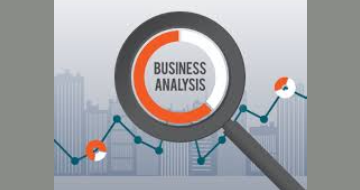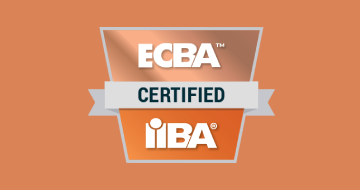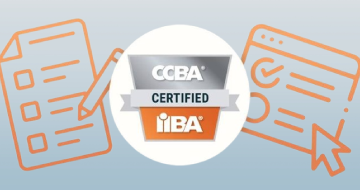IIRF Online > Business > Business Strategy > IIBA Entry Certificate in Business Analysis (ECBA) > Business Analysis Professional (ECBA/CBAP) (PBA)
Business Analysis Professional (ECBA/CBAP) (PBA) by Udemy
50 PDU/PDH ECBA/CBAP PBA Certificate Exam Prep (IIBA ECBA/CBAP) (PMI PBA)
Course Highlights
- Understand foundational principles of business analysis and its significance.
- Master techniques to elicit, analyze, and document requirements.
- Build effective communication strategies with diverse stakeholders.
- Learn to assess and validate solutions to ensure alignment with business needs.
- Gain hands-on proficiency with popular BA tools for data modeling and analysis.
- Equip with essential knowledge to confidently tackle the IIBA - ECBA exam.
Skills you will learn!
Curriculum
9 Topics
Intro - Business Analysis Professional
A day in the life of a business analyst
Course Choice
Skill Development and Prior Knowledge
Program Overview
Effective Learning
Placement test
Babok v3 Structure
FAQs
24 Topics
Overview
Business Analysis - Definition and Context
The Science of Better Learning
The Business Analyst's Role
The Value of Business Analysis
Business Analysis (beyond projects)
Exercise - Understanding Business Analysis
Business Analysis Knowledge Areas
Tools and Techniques for BOBOK Guide v3.
Relationships Between Knowledge Areas
Business Analysis Key Terms
Business Analysis Core Concepts
The BACCM Model
Exercise: Business Analysis Key Terms and Concepts
Stakeholders Within a Project Team
Stakeholders External to the Project
The BACCM Components
Requirements Classification Schema
Requirements and Designs
The Requirements and Design Cycle
Requirements and design concepts
Exercise: Stakeholders; Requirements and Designs
Introduction to Business Analysis
Introduction to Business Analysis (IIBA - CBAP)
34 Topics
Overview
Overview of Business Anlysis Planning and Monitoring
The Core Concept Model in Business Analysis Planning and Monitoring
Business Analysis Planning and Monitoring and the Business Analysis Core Concept
Exercise: Understanding Business Analysis Planning and Monitoring
Business Analysis Planning and Monitoring Input/Output Diagram
Plan Business Analysis Approach: Inputs and Elements
Plan Business Analysis Approach: Guidelines and Techniques
Plan Business Analysis Approach: Stakeholders and Output
Plan Business Analysis Approach Input/Output Diagram
Formality and Level of Detail of Business Analysis Deliverables
Exercise: Planning the Business Analysis Approach
Plan Stakeholder Engagement: Inputs and Elements
Plan Stakeholder Engagement: Guidelines & Techniques
Plan Stakeholder Engagement: Stakeholders & Outputs
Plan Stakeholder Engagement Input/Output Diagram
Exercise: Planning Stakeholder Engagement
Plan Business Analysis Governance: Inputs and Elements
Plan Business Analysis Governance: Guidelines and Techniques
Plan Business Analysis Governance: Stakeholders and Outputs
Plan Business Analysis Governance Input/Output Diagram
Exercise: Planning Business Analysis Governance
Plan Information Management: Inputs and Elements
Plan Information Management: Guidelines & Techniques
Plan Information Management: Stakeholders & Outputs
Plan Business Analysis Information Management Input/Output Diagram
Exercise: Planning BA Information Management
Performance Improvements: Inputs and Elements
Performance Improvements: Guidelines and Techniques
Performance Improvements: Stakeholders and Outputs
Identify Business Analysis Performance Improvements Input/Output Diagram
Exercise: Identifying Business Analysis Performance Improvements
Business Analysis Planning and Monitoring
Business Analysis Planning and Monitoring (IIBA - CBAP)
33 Topics
Overview
Overview of Elicitation and Collaboration
The Core Concept Model in Elicitation and Collaboration
Elicitation and Collaboration Input/Output Diagram
Core Concepts and the Business Analyst's Role
Exercise: Understand Elicitation and Collaboration
Prepare for Elicitation: Inputs and Elements
Prepare for Elicitation: Guidelines and Techniques
Prepare for Elicitation: Stakeholders and Outputs
Prepare for Elicitation Input/Output Diagram
Exercise: Preparing for Elicitation
Conduct Elicitation: Inputs and Elements
Conduct Elicitation: Guidelines and Techniques
Conduct Elicitation: Stakeholders and Outputs
Conduct Elicitation Input/Output Diagram
Exercise: Conducting Elicitation
Confirm Elicitation Results: Inputs and Elements
Confirm Elicitation Results: Guidelines and Techniques
Confirm Elicitation Results: Stakeholders and Outputs
Confirm Elicitation Results
Exercise: Confirming Elicitation Results
Communicating BA Information: Inputs and Elements
Communicating BA Information: Guidelines and Techniques
Communicating BA Information: Stakeholders and Outputs
Communicate Business Analysis Information Input/Output Diagram
Exercise: Communicating BA Information
Stakeholder Collaboration: Inputs and Elements
Stakeholder Collaboration: Guidelines and Techniques
Stakeholder Collaboration: Stakeholders and Outputs
Manage Stakeholder Collaboration Input/Output Diagram
Exercise: Managing Stakeholder Collaboration
Business Analysis Elicitation and Collaboration (IIBA -CBAP)
Business Analysis Elicitation and Collaboration
31 Topics
Overview
Requirements Life Cycle Management
Requirements Life Cycle Management Model
Requirements Management and the BACCM (TM)
Requirements Life Cycle Management Input/Output Diagram
Exercise - Understanding Requirements Management
Requirements and Traceability
Trace Requirements - Inputs and Elements
Process Traceability Diagram
Trace Requirements - Guidelines and Techniques
Trace Requirements - Stakeholders and Outputs
Exercise - Trace Requirements
Maintain Requirements - Elements and Guidelines
Maintain Requirements Input/Output Diagram
Maintain Requirements - Techniques and Stakeholders
Prioritise Requirements - Inputs and Elements
Prioritise Requirements - Guidelines and Techniques
Prioritize Requirements Input/Output Diagram
Prioritise Requirements - Stakeholders and Outputs
Exercise - Maintain and Prioritize Requirements
Assess Requirements Changes - Inputs and Elements
Assess Requirements Changes Input/Output Diagram
Assess Requirements Changes - Guidelines and Techniques
Assess Requirements Changes - Stakeholders and Outputs
Approve Requirements - Inputs and Elements
Approve Requirements Input/Output Diagram
Approve Requirements - Guidelines and Techniques
Exercise - Assess and Approve Requirements
Business Analysis and Requirements Life Cycle Management
Certification Program & Practical Approaches (IIBA - CBAP)
Business Analysis and Requirements Life Cycle Management
28 Topics
Overview
Introduction to Strategy Analysis
Business Analysis Value Spectrum
Strategy Analysis and the BACCM (TM)
Strategy Analysis Input/Output Diagram
The Core Concept Model in Strategy Analysis
Exercise: Understanding Strategy Analysis
Analyze Current State: Inputs and Elements
Analyse Current State: Guidelines and Techniques
Analyze Current State: Stakeholders and Outputs
Analyze Current State Input/Output Diagram
Define Future State: Inputs and Elements
Define Future State: Guidelines and Techniques
Define Future State: Stakeholders and Outputs
Define Future State Input/Output Diagram
Exercise: Define Current and Future States
Assess Risks: Inputs and Elements
Assess Risks: Guidelines and Techniques
Assess Risks: Stakeholders and Outputs
Assess Risks Input/Output Diagram
Exercise: Performing a Risk Assessment
Define Change Strategy: Inputs and Elements
Define Change Strategy: Guidelines and Techniques
Define Change Strategy: Stakeholders and Output
Define Change Strategy Input/Output Diagram
Exercise: Developing a Change Strategy
Business Analysis and Strategy Analysis
Business Analysis and Strategy Analysis (IIBA - CBAP)
21 Topics
Overview
Overview of RADD
Business Analysis Value Spectrum
RADD and the BACCM (TM)
The Core Concept Model in Requirements Analysis and Design Definition
Requirements Analysis and Design Definition Input/Output Diagram
Exercise: Understanding RADD
Specify and Model Requirements: Inputs and Elements
Requirements Modeling: Guidelines and Tools
Specify and Model Requirements Input/Output Diagram
Exercise: Defining Requirements
Verify Requirements: Inputs and Elements
Verify Requirements: Tools and Techniques
Verify Requirements Input/Output Diagram
Exercise: Verifying Requirements
Validate Requirements: Inputs and Elements
Validate Requirements: Guidelines and Techniques
Validate Requirements Input/Output Diagram
Exercise: Validating Requirements
Requirements Analysis and Design Definition (RADD)
Requirements Analysis and Design Definition
19 Topics
Overview
Requirements Architecture Overview
Define Requirements Architecture: Inputs and Elements
Define Requirements Architecture: Techniques
Define Requirements Arhitecture Input/Output Diagram
Exercise: Defining the Requirements Architecture
Define Design Options: Inputs and Elements
Define Design Options: Guidelines and Techniques
Define Design Options: Stakeholders and Outputs
Define Design Options Input/Output Diagram
Exercise: Defining Design Options
Analyze Potential Value: Inputs and Elements
Analyze Potential Value: Guidelines and Techniques
Recommend Solution: Elements and Outputs
Analyze Potential Value and Recommend Solution Input/Output Diagram
Exercise: Creating RADD's Final Output
Requirements Architecture and Design Options
Requirements Architecture and Design Options
Concepts; Insights and Inquiries
25 Topics
Overview
Overview of Solution Evaluation
Business Analysis Value Spectrum
The Core Concept Model in Solution Evaluation
Solution Evaluation and the BACCM TM
Solution Evaluation Input/Output Diagram
Exercise: Understanding Solution Evaluation
Measure Solution Performance: Inputs and Elements
Measure Solution Performance: Guidelines and Techniques
Analyze Performance Measures: Inputs and Elements
Analyze Performance Measures: Stakeholders
Measure Solution Performance Input/Output Diagram
Exercise: Assessing Solution Performance
Solution Limitations: Elements and Guidelines
Solution Limitations: Techniques and Stakeholders
Enterprise Limitations: Inputs and Elements
Enterprise Limitations: Techniques and Stakeholders
Analyze Performance Measures Input/Output Diagram
Exercise: Assessing Limitations
Recommend Actions: Elements
Recommend Actions: Guidelines and Techniques
Assess Solution Limitations Input/Output Diagram
Exercise: Increasing Solution Value
Business Analysis and Solution Evaluation (IIBA - CBAP)
Business Analysis and Solution Evaluation
37 Topics
Overview
Benchmarking and Market Analysis
Document Analysis
Scope Modeling
State Modelling
State Transition Diagram
Exercise: Scoping and Planning Tools
Process Modeling
Flowchart/Business Process Model/Activity Diagram
Process Analysis
SIPOC Model/Value Stream Map
Organizational Modeling
Functionally-oriented Organizational Model
Interface Analysis
Interface Analysis Diagram
Data Flow Diagrams
Context and Data Flow Diagrams
Data Mining
Data Modeling
Entity-Relationship Diagram (Crow's Foot Notation)/Class Diagram
Prototyping
Exercise: Business Analysis Models
Risk Analysis and Management
Example of a Risk Register
Financial Analysis
Example of a Cost-Benefit Analysis
Root Cause Analysis
Fishbone Diagram
SWOT Analysis
SWOT Matrix
Decision Modelling and Decision Analysis
Simple/Weighted Decision Matrix
Decision Table/Tree
Exercise: Decision-making Analysis Tools
Concepts; Techniques and Applications (IIBA - CBAP)
Analytical Techniques for Business Analysis (IIBA - CBAP)
Analytical Techniques for Business Analysis (IIBA - CBAP)
30 Topics
Overview
Brainstorming and Mind Mapping
Brainstorming Diagram
The Taxonomy of a Mind Map
Focus Groups and Workshops
Surveys and Questionnaires
Interviews and Observation I
Interviews and Observation II
Lessons Learned and Collaborative Games
Examples of Collaborative Games
Exercise: Group Activities in Knowledge Sharing
Estimation
Prioritization
Approaches to Prioritisation
Reviews and Item Tracking
Vendor Assessment
Exercise: Techniques to Support Decision Making
Stakeholder List; Map; and Personas
Stakeholder Matrix
Stakeholder Onion Diagram
RACI Matrix
Backlog Management
Balanced Scorecard
Balanced Scorecard Diagram
Roles and Permissions Matrix
Business Model Canvas
Functional Decomposition Diagram
Exercise: Using Business Analysis Tools
10 Most Popular Business Analysis Techniques
Activities and Tools Used for Business (IIBA - CBAP)
21 Topics
Overview
Glossary and Data Dictionary
Example of a Data Dictionary
Concept Modelling
Business Rules Analysis
Exercise: Understanding Glossaries and Rules
Business Cases
Business Capability Analysis
Sample Capability Map
Use Cases and Scenarios
Use Case Diagram
Sequence Diagrams
Elements Sequence Diagrams
User Stories
Exercise: Understanding Business and Use Cases
Metrics and Key Performance Indicators (KPIs)
Acceptance and Evaluation Criteria
Acceptance and Evaluation Criteria - one/multiple solutions
Nonfunctional Requirements Analysis
Exercise: Understanding Metrics and Criteria
Documentation and Criteria Used for Business Analysis
15 Topics
Overview
Creative and Visual Thinking
Conceptual and Systems Thinking
Decision Making and Problem Solving
Exercise: Analytical Thinking Core Competencies
Teamwork; Facilitation; and Teaching
Leadership and Negotiation Skills
Exercise: Interaction Core Competencies
Communication Skills Overview
Verbal Communication
Nonverbal Communication
Written Communication
Effective Listening Skills
Exercise: Communication Core Competencies
Business Analysis Competencies: Personal Skills
17 Topics
Overview
Ethical Behaviour
Personal Accountability
Trustworthiness
Adaptability
Organization and Time Management
Exercise: Behavioural Core Competencies
Business Acumen
Industry Knowledge
Organization; Methodology; and Solution Knowledge
Exercise: Business Knowledge Competencies
Office Productivity Tools and Technology
Business Analysis Tools and Technology
Communication Tools and Technology
Exercise: Using BA Tools and Technologies
Business Analysis Competencies: Professional Effectiveness
Practical Activity: Decision-Making & Communication
33 Topics
Overview
Overview of the Agile Perspective
Agile Approaches
Agile and Business Analysis
Agile: Approaches; Techniques; and Competencies
Techniques used within Agile Approaches
Exercise: Understanding the Agile Perspective
Overview of the Business Intelligence Perspective
Business Intelligence Solution - Conceptual Framework
Business Intelligence and the Business Analyst
Exercise: Understanding the BI Perspective
IT Initiatives and the Business Analyst
Information Technology Methodologies
Change in the Information Technology Context
Information Technology Methodologies
Business Architecture and the Business Analyst
Exercise: Understanding the IT Perspective
Overview of Business Architecture
Business Architecture Reference Models
Business Architecture Techniques
Business Architecture Techniques Table
Exercise: Understanding Business Architecture
Business Process Management Overview
BPM and the Business Analyst
Business Analyst Roles in a BPM Initiative
BPM Frameworks; Methodologies; and Techniques
BPM Frameworks
BPM Methodologies
BPM Techniques
Exercise: Understanding Business Process Management
Business Analysis Perspectives
IIBA Certifications
The Business Analysis Certification Program (IIBA - CBAP)
21 Topics
Business Analysis for Practitioners: A Practice Guide
Purpose of this Practice Guide
Need for this Practice Guide
PMI’s Increased Focus on Business Analysis
Intended Audience for the Guide
What is Business Analysis?
Skillset and Expertise Needed for the Business Analysis Role
Who Performs Business Analysis?
How Organizations Implement Business Analysis
The Relationship Between the Project Manager; Business Analyst
The Need to Build the Relationships
Definition of Requirement
Who has the Responsibility for the Requirements?
Requirement Types
The Structure of the Practice Guide
Section 2 on Needs Assessment
Section 3 on Business Analysis Planning
Section 4 on Requirements Elicitation and Analysis
Section 5 on Traceability and Monitoring
Section 6 on Solution Evaluation
Business analysis for practitioners: A practice guide (PMI PBA)
44 Topics
Why Perform Needs Assessments
Identify Problem or Opportunity
Identify Stakeholders
Investigate the Problem or Opportunity
Gather Relevant Data to Evaluate the Situation
Draft the Situation Statement
Obtain Stakeholder Approval for the Situation Statement
Assess Current State of the Organization
Assess Organizational Goals and Objectives
Goals and Objectives
SMART Goals and Objectives
SWOT Analysis
Relevant Criteria
Perform Root Cause Analysis on the Situation
Cause-and-Effect Diagrams
Fishbone Diagrams
Interrelationship Diagrams
Process Flows
Determine required capabilities needed to address the situation
Capability Table
Affinity Diagram
Benchmarking
Assess Current Capabilities of the Organization
Identify Gaps in Organizational Capabilities
Recommend Action to Address Business Needs
Include a High-Level Approach for Adding Capabilities
Provide Alternative Options for Satisfying the Business Need
Identify Constraints; Assumptions; and Risks for Each Option
Constraints
Risks
Assess Feasibility and Organizational Impacts of Each Option
Operational Feasibility
Technology/System Feasibility
Cost-Effectiveness Feasibility
Time Feasibility
Recommend the Most Viable Option
Weighted Ranking
Conduct Cost-Benefit Analysis for Recommended Option
Payback Period (PBP)
Internal Rate of Return (IRR)
Net Present Value (NPV)
Assemble the Business Case
Value of the Business Case
Needs assessment
28 Topics
The Importance of Business Analysis Planning
Rationale
Business Analysis Planning and Project Management Planning
Conduct or Refine the Stakeholder Analysis
Techniques for Identifying Stakeholders
Brainstorming
Organizational Charts
Determine Stakeholder Characteristics
Techniques for Grouping or Analyzing Stakeholders
Create the Business Analysis Plan
Business Analysis Plan vs. Requirements Management Plan
What to Include in the Business Analysis Plan
Understand How the Project Life Cycle Influences Planning Decisions
Ensure the Team is Trained on the Project Life Cycle
Leverage Past Experiences When Planning
Plan for Elicitation
Plan for Analysis
Define the Traceability Approach
Define the Communication Approach
Define the Decision-Making Process
Define the Requirements Verification and Validation Processes
Define the Requirements Change Process
Define the Solution Evaluation Process
Plan the Business Analysis Work
Build the Business Analysis Work Plan
Assemble the Business Analysis Work Plan
Document the Rationale for the Business Analysis Approach
Obtain Approval of the Business Analysis Plan
72 Topics
Plan for Elicitation
Develop the Elicitation Plan
Prepare for elicitation
Conduct Elicitation Activities
Introduction
Body
Close
Follow-Up
Elicitation Techniques - Brainstorming
Elicitation Techniques - Document Analysis
Elicitation Techniques - Facilitated Workshops
Elicitation Techniques - Focus Groups
Elicitation Techniques - Interviews
Elicitation Techniques - Observation
Elicitation Techniques - Prototyping
Elicitation Techniques - Questionnaires and Surveys
Document Outputs from Elicitation Activities
Complete Elicitation
Elicitation Issues and Challenges
Analyze Requirements
Model and Refine Requirements
Purpose of Models
Categories of Models
Selection of Models
Use Models to Refine Requirements
Modeling Languages
Scope Models
Ecosystem Map
Context Diagram
Feature Model
Use Case Diagram
Process Models
Use Case
User Story
Rule Models
Decision Tree and Decision Table
Data Models
Data Flow Diagrams
Data Dictionary
State Table and State Diagram
Interface Models
System Interface Table
User Interface Flow
Wireframes and Display-Action-Response
Document the Solution Requirements
Why Documentation is Important
Business Requirements Document
The Solution Documentation
Requirements
Categorization
Requirements Specification
Documenting Assumptions
Documenting Constraints
Guidelines for Writing Requirements
Functional Requirements
Prioritizing Requirements
Technical Requirements Specification
Documenting with Use Cases
Documenting with User Stories
Backlog Items
Validate Requirements
Requirements Walkthrough
Verify Requirements
Peer Review
Inspection
Approval Sessions
Resolve Requirements-Related Conflicts
Delphi
Multivoting
Weighted Ranking
Requirements elicitation and analysis
Business analysis for practitioners: A practice guide (PMI PBA)
4 Topics
Ready to ace the CBAP/PBA exams?
Takeaways
Practical Applications and Endorsements
What's next?

Business Analysis Professional (ECBA/CBAP) (PBA)






